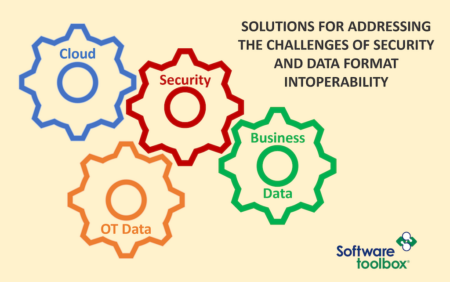SPONSORED BY: SOFTWARE TOOLBOX
 The exchange of data between OT systems or between OT and IT or business systems plays a pivotal role in ensuring efficient and robust industrial operations. Digital transformation initiatives demand rapid information exchange. Historically, solutions to these challenges are a landscape of custom software applications. Workforce capacity limitations demand solutions that are sustainable over time without the use of custom software code.
The exchange of data between OT systems or between OT and IT or business systems plays a pivotal role in ensuring efficient and robust industrial operations. Digital transformation initiatives demand rapid information exchange. Historically, solutions to these challenges are a landscape of custom software applications. Workforce capacity limitations demand solutions that are sustainable over time without the use of custom software code.
The OPC UA standard and its capabilities for data publish/subscription and standardized information models are going a long way to take integration beyond custom code and just basic data transfer, the original problems OPC set out to solve many years ago. In a prior article in this newsletter, we looked at the use cases for these OPC UA functionalities. Earlier this year, we shared ways to leverage your investment in OPC and move to OPC UA, and more recently we looked at ways to protect OPC UA data with store & forward solutions.
To wrap up 2023, we want to look at the JSON format for data, which the OPC UA part 6 specifies as a data encoding that can be used for OPC UA data types and can be used in OPC UA PubSub messages. JSON is also a data encoding format used in REST web services which are used extensively in the IT landscape. The OPC Foundation UA working group is exploring use cases for REST and OPC UA as covered in a March 2023 article, which eventually may further expand OPC UA’s open integration with other technologies. Until then, what can you do today?
What is JSON? Advantages Over Traditional File/Data Transfer Formats
For decades, one of the approaches to storing and exchanging data was through CSV files, enabling businesses to maintain data in a tabular format. Although CSV remains a viable solution for data storage and exchange, the advent of the Cloud IoT (Internet of Things) era has introduced alternative, more straightforward formats for data storage, such as JSON.
JSON is a JavaScript-based standard used for transmission of structured data via the internet. JSON is often used as value or parameter input or output. JSON is a valuable exchange format between web clients and backend services. JSON offers several key advantages over CSV, including support for larger file sizes, handling hierarchical and relational data, seamless integration with APIs, scalability, and optimal performance when dealing with extensive and complex datasets.
Many solutions for JSON interchange of data require users to write code and deeply understand JSON expressions and other details. Solutions that don’t use code, provided they are flexible enough, are inherently more sustainable and have a lower cost of ownership.
What If you Need to Integrate Now Without Writing Code?
Off-the-shelf solutions have emerged that help manage data acquired from OT systems via OPC DA or UA and visually transform it into JSON files that seamlessly interface with destination systems like InfluxDB, MQTT Brokers/Clients, and REST Webservices, thereby harnessing the benefits of this powerful data format with out the risks and long-term costs of custom code.
OPC Router is one of these solutions. The off-the-shelf software product uses a visual workflow engine and connectors to integrate OT protocols, IoT systems, cloud systems, and ERP systems including native SAP connectors. Implementers can visually create workflows to map, transform data and trigger movement, then templatize them and use mass configuration tools in the software to scale up their configurations. Solutions can be deployed in Docker containers on Linux edge devices or Windows systems to meet a variety of solution architectures.
You can learn more in our detailed tutorial referenced at the end of this article, but in the example below, we have used OPC Router’s transfer objects to connect an OPC UA Server and then map the data to the OPC Router JSON Write transfer object. Although in this application, we write a file, the same dataset could be served up in a RESTful web service. The solution could also be reversed to consume data as a RESTful web client from a web service, and then deliver it to an OPC server. OPC Router also supports ETL tools for XML and CSV, all without writing any code.
To learn more or to request a free consult, visit the OPC Router Website, Contact Us, or access the detailed how to resources below.
- OPC Router Quick Start & Application Guides
- Consuming OPC UA data and generating JSON datasets
- Video Training Tutorial Connecting RESTful Web Services to OPC UA & OPC DA
Conclusion
OT/IT/Business data interchange requires consideration of the security of data transport, and then the needs to transform the data between formats, all without the use of custom software and code. Software Toolbox provides off-the-shelf solutions combined with the expertise to support users, integrators, and OEMs in their implementations.
